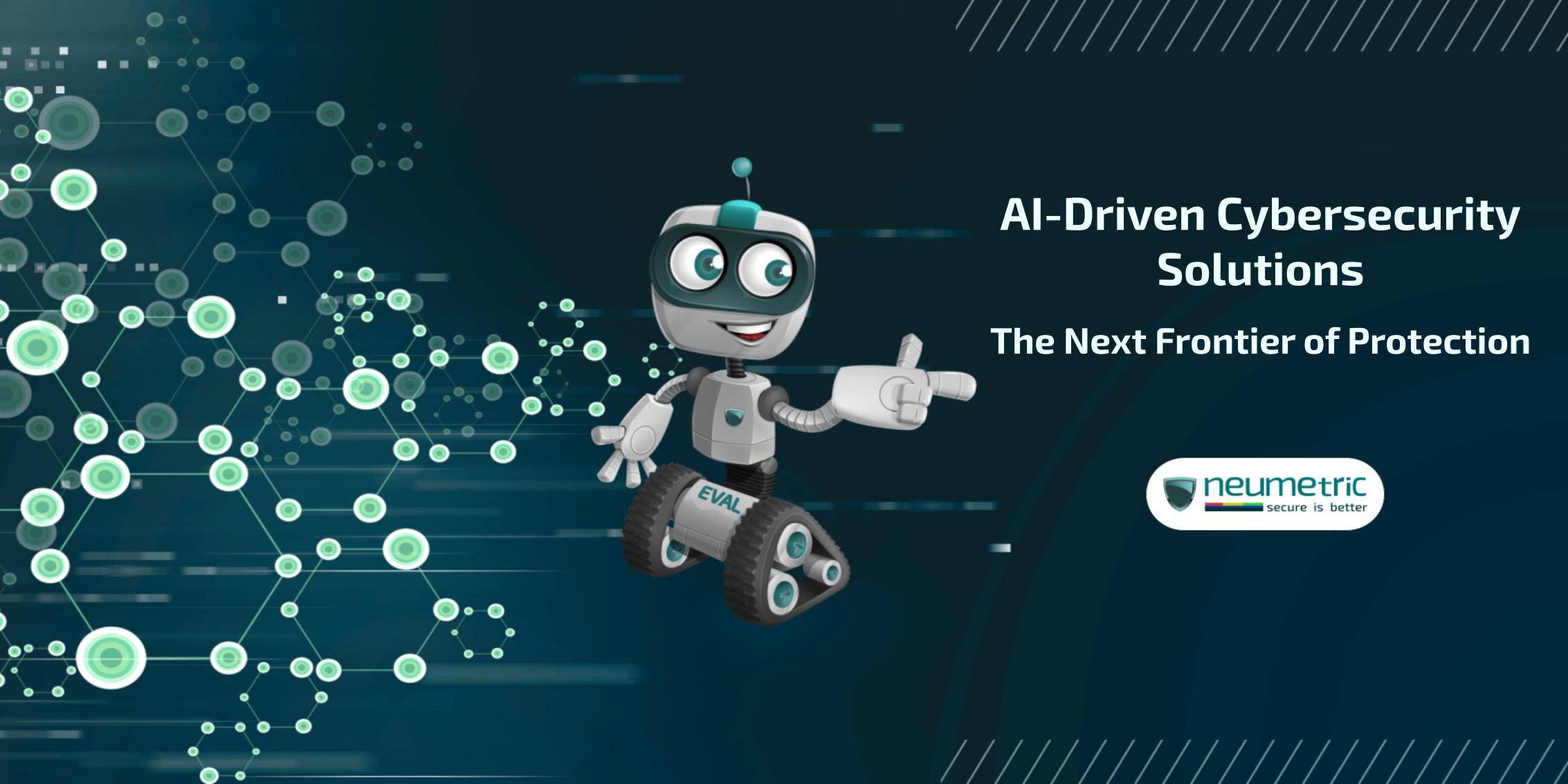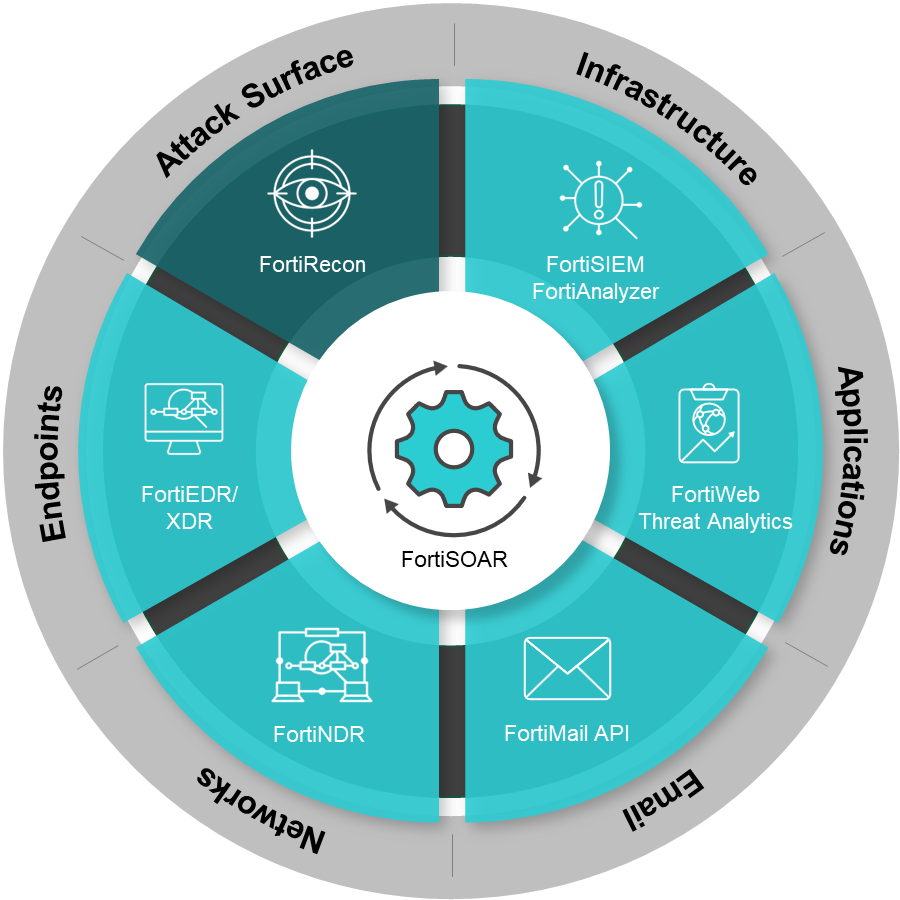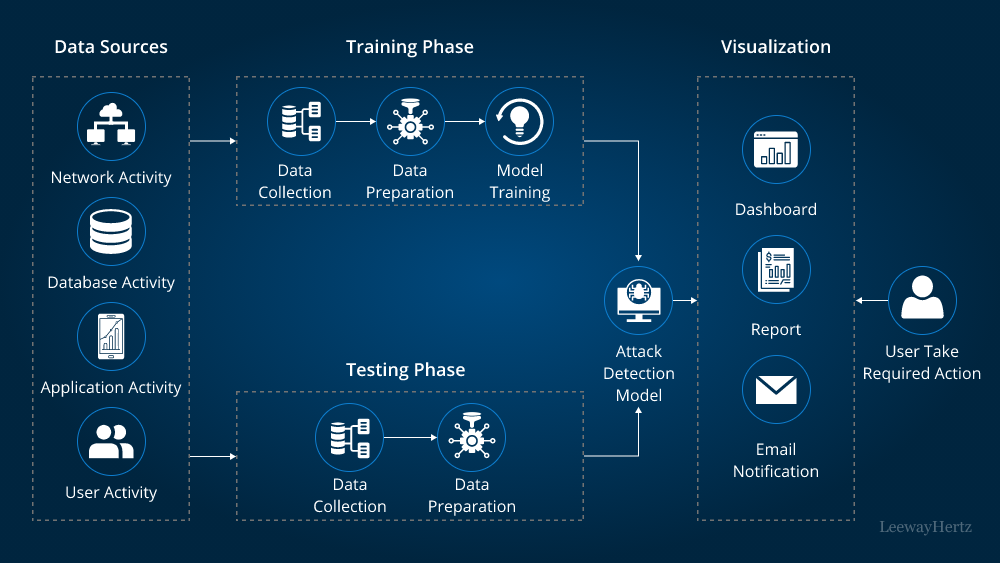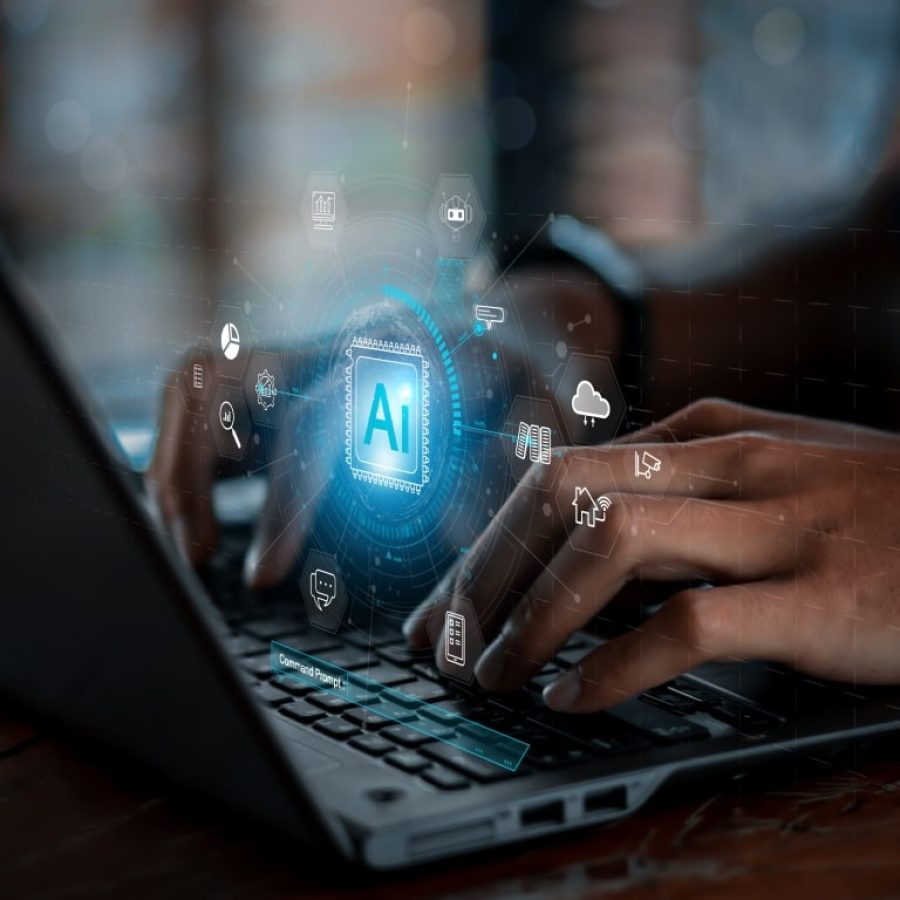AI-Driven Security Solutions: Enhancing Cyber Protection for Your Business. Discover how AI-driven security solutions are revolutionizing safety. Explore smart tech that protects your home and business with ease and efficiency!
Importance of AI-Driven Security Solutions
The integration of AI-Driven Security Solutions: Enhancing Cyber Protection for Your Business is essential for today’s organizations. Cyber threats grow every day. Businesses face risks that can compromise data. A proactive security approach can help reduce these risks. AI helps in identifying threats in real-time.
Many companies are moving towards AI solutions. They recognize the power of AI in cyber defense. AI can analyze vast amounts of data quickly. This speed allows for better protection against breaches. Additionally, AI learns from past incidents. This continuous learning improves future security measures.
Types of AI-Driven Security Solutions
Various types of AI-Driven Security Solutions: Enhancing Cyber Protection for Your Business are available. These tools serve different purposes. Here are some common types:
- Intrusion Detection Systems (IDS)
- Security Information and Event Management (SIEM)
- Predictive Analytics Tools
- Endpoint Protection Solutions
- Fraud Detection Systems
Intrusion Detection Systems (IDS)
IDS monitor network traffic. They identify potential threats. AI enhances these systems by providing real-time analysis. They can differentiate between normal and abnormal behavior. Alerts are generated when suspicious activity appears. Businesses can respond quickly to prevent breaches.
Security Information and Event Management (SIEM)
SIEM solutions gather data from various sources. They analyze this information for security events. AI-driven SIEM can correlate events better than traditional systems. This leads to faster incident response. These tools help in compliance reporting as well.
Benefits of AI-Driven Security Solutions
Implementing AI-Driven Security Solutions: Enhancing Cyber Protection for Your Business offers numerous benefits. Organizations can enjoy improved security effectiveness and efficiency. Here are some key advantages:
| Benefit | Description |
|---|---|
| Faster Response Times | AI detects threats instantly, enabling quick action. |
| Reduction of False Positives | AI improves threat detection accuracy, cutting unnecessary alerts. |
| Cost Efficiency | Automated solutions save labor costs and resources. |
Challenges in Implementing AI-Driven Security Solutions
While AI-Driven Security Solutions: Enhancing Cyber Protection for Your Business offer benefits, challenges exist. Organizations may encounter various hurdles. Some of these include:
- High Initial Costs
- Data Privacy Concerns
- Lack of Skilled Personnel
- Integration with Existing Systems
High Initial Costs
The implementation of AI systems requires significant upfront investment. This high cost may deter some businesses. However, organizations must view it as a long-term investment. Over time, these solutions can save money by preventing costly breaches.
Data Privacy Concerns
AI systems process large volumes of sensitive data. This can raise privacy issues. Companies need to ensure compliance with data protection regulations. They must focus on securing and anonymizing data.
AI in Threat Intelligence
AI-Driven Security Solutions: Enhancing Cyber Protection for Your Business involves threat intelligence. AI helps in gathering and analyzing threat data. This analysis provides insights into potential risks. Organizations can use this information to strengthen their defenses. An effective threat intelligence system includes:
| Feature | Description |
|---|---|
| Real-time Data Processing | AI analyzes data as it arrives for immediate insights. |
| Behavioral Analysis | AI detects anomalies in user behavior to spot threats. |
AI-Driven Security Analytics
Security analytics powered by AI enhances insights into data. These analytics help in rectifying past incidents. They can detect patterns in attacks, allowing organizations to strengthen defenses. An AI-driven approach improves analytics in several ways:
- Automation of Data Collection
- Correlation of Events
- Rich Visualization of Data
Automation of Data Collection
Automated data collection frees up time for security personnel. It allows them to focus on high-level tasks. AI collects data from various sources seamlessly. This clears the path for quicker decisions. Automated analytics produce more reliable outcomes.
Correlation of Events
AI can correlate security events across multiple systems. This provides a comprehensive view of security incidents. It helps in identifying potential risks quickly. With improved correlation, organizations can react efficiently.
Integrating AI with Existing Security Infrastructure
Integrating AI-Driven Security Solutions: Enhancing Cyber Protection for Your Business with existing systems is crucial. It ensures a cohesive approach to security. Organizations must plan this integration carefully. Here are some essential steps:
- Assess Current Infrastructure
- Define Integration Goals
- Choose Compatible AI Solutions
Assess Current Infrastructure
Organizations must review existing security tools and protocols. Understanding what is currently in place aids in selecting suitable AI systems. This assessment should include software, hardware, and personnel considerations.
Define Integration Goals
Setting clear goals for integration helps in its success. These goals should align with the overall business strategy. Organizations must ensure that AI solutions address their specific security needs.
AI and Incident Response
AI significantly boosts the incident response process. With AI-Driven Security Solutions: Enhancing Cyber Protection for Your Business, responses can be automated and improved. Here’s how AI aids in incident response:
| Aspect | AI Contribution |
|---|---|
| Incident Detection | AI identifies anomalies rapidly for quick review. |
| Response Actions | AI can automate responses to specific threats. |
The Future of AI in Cybersecurity
The future holds immense potential for AI in cybersecurity. As threats grow more sophisticated, AI’s role will become even more critical. Key developments to anticipate include:
- Enhanced Machine Learning Capabilities
- Adoption of AI in Predictive Security Models
- Greater Automation in Response Procedures
Enhanced Machine Learning Capabilities
Machine learning algorithms will evolve continuously. These advancements will enable systems to better detect and mitigate threats. As data increases, machine learning will adapt quickly. Organizations will benefit significantly from these developments.
Adoption of AI in Predictive Security Models
Predictive security models will use AI for forecasting potential threats. By analyzing patterns, these models will help in proactive threat management. This ensures that organizations can prepare before issues arise.
Collaboration Between AI and Human Analysts
The combination of AI-Driven Security Solutions: Enhancing Cyber Protection for Your Business and human analysts provides the best protection. AI handles data analysis, while humans oversee strategy. The collaboration includes:
- AI-Assisted Decision Making
- Enhancing Human Skills with AI Insights
AI-Assisted Decision Making
AI offers valuable insights for human decision-making. This allows analysts to make informed choices during incidents. AI can suggest possible actions based on previous data, improving response times.
Enhancing Human Skills with AI Insights
AI delivers data that strengthens analyst skills. This includes information on emerging threats and vulnerabilities. By using AI insights, analysts can become more effective in their roles. This partnership enhances the entire security framework.
“AI-Driven Security Solutions: Enhancing Cyber Protection for Your Business can transform the way organizations manage threats.” – Orland Conn
Choosing the Right AI-Driven Security Solution
Organizations must choose the right AI security solutions. Specific criteria should guide this choice:
| Criteria | Description |
|---|---|
| Scalability | Solutions should grow with business needs. |
| Ease of Integration | The solution must work smoothly with existing systems. |
| Support and Training | Providers should offer comprehensive support and training. |
Real-world Applications of AI in Cybersecurity
Real-world examples showcase the effectiveness of AI-Driven Security Solutions: Enhancing Cyber Protection for Your Business. These applications illustrate AI’s impact:
- Financial Sector: Fraud detection systems using AI.
- Healthcare: Securing patient data with AI analytics.
- Retail: Monitoring transactions for suspicious activities.
Financial Sector
The financial industry greatly benefits from AI. Fraud detection systems analyze transaction patterns. They alert institutions to anomalies quickly. This helps prevent unauthorized access and financial losses.
Healthcare
In healthcare, AI secures sensitive patient data. Analytics systems track access patterns. Any unusual activity triggers alerts. This protects personal health information from breaches.
Investing in AI-Driven Security Solutions
Investing in AI-Driven Security Solutions: Enhancing Cyber Protection for Your Business is critical for future growth. Companies should consider various factors before investing, such as:
- Long-term Vision
- Current Threat Landscape
- Available Budget
Long-term Vision
Organizations must align their security investments with long-term goals. This ensures that the chosen AI solutions will remain suitable down the line. Adaptability is essential in this sector.
Current Threat Landscape
Companies should analyze their current threat landscape. Understanding existing vulnerabilities will inform investment decisions. Prioritizing high-risk areas can help allocate resources efficiently.

Industry Impact of AI-Driven Security Solutions
AI-Driven Security Solutions: Enhancing Cyber Protection for Your Business changes how businesses work. Hackers get smarter every day. Traditional methods need updates. AI works continuously to give real-time security. This helps block threats before they cause damage.
Different industries feel the impact of these solutions. Let’s check some examples:
| Industry | Impact |
|---|---|
| Finance | Detects fraud in real-time. |
| Healthcare | Secures patient data quickly. |
| Retail | Monitors transactions for anomalies. |
| Manufacturing | Protects intellectual property. |
AI helps businesses be proactive. They can identify risks before they become threats. Companies can make decisions based on data insights. This is crucial for operational efficiency.
Protection Against Data Breaches
Data breaches harm companies. They cause financial loss and damage reputation. With AI security, organizations can get alerts. This leads to quick incident response. Businesses can avoid or minimize breaches using intelligent systems.
Cost-Effectiveness
Investing in AI does save money long-term. Companies may need fewer staff for monitoring. AI provides round-the-clock coverage. Machines work faster than humans. This speeds up incident detection and response.
Technological Innovations in AI Security
AI-Driven Security Solutions: Enhancing Cyber Protection for Your Business offers many technological innovations. These advances shape how businesses protect themselves. Here are key innovations:
- Machine learning algorithms
- Automated incident response
- Threat intelligence platforms
- Behavioral analytics
Machine Learning Algorithms
Machine learning can detect patterns. It analyzes data sets quickly. This helps find hidden threats. The AI learns from past attacks to improve future responses. It updates itself continuously.
Automated Incident Response
Automation reduces response times. When a threat is detected, systems act immediately. This minimizes damage. Businesses don’t need human intervention for all minor issues. It saves time and resources.
Threat Intelligence Platforms
These platforms gather information on new threats. Organizations can share this data. Collaboration enhances overall protection. Knowing potential risks leads to better preparation.
User Experiences with AI Security Systems
User experiences show the benefits of AI-Driven Security Solutions. Clients share thoughts on ease of use. Satisfaction is high when security measures are simple. Below are typical feedback examples:
| User | Experience |
|---|---|
| Client A | Fast response times improved safety. |
| Client B | Ease of integration with existing systems. |
| Client C | Reduced false positives. |
| Client D | Increased confidence in data security. |
Simple interfaces and clear instructions lead to positive feedback. Users find it helpful when training materials are available. Continuous support helps users feel comfortable using the systems.
Real-Time Monitoring Benefits
Real-time monitoring is a major benefit. It gives a bird’s eye view of security. Users can see issues as they happen. This prevents small problems from becoming big threats. Companies can respond effectively.
Integration With Existing Systems
Easy integration is crucial for success. AI security solutions must work with current technology. This reduces replacement costs. Users appreciate seamless transitions. Less downtime means more business focus.
Future Trends in AI-Driven Security
The future is bright for AI-Driven Security Solutions: Enhancing Cyber Protection for Your Business. Trends have a big impact on how security evolves:
- Increased use of AI in cloud security.
- Advance in predictive analytics.
- Collaboration with cybersecurity firms.
- Stronger emphasis on compliance.
Impact of Cloud Security
Cloud services grow more popular daily. AI will play a vital role in securing these services. Users need assurance their data is safe. AI can monitor cloud activities and alert users to irregularities quickly.
Advancements in Predictive Analytics
Predictive analytics helps businesses prepare. AI can look at past data. This reveals patterns that indicate future risks. Organizations can create strategies to tackle these threats early.
“AI-Driven Security Solutions: Enhancing Cyber Protection for Your Business is reshaping security practices. Companies must adapt.” – Alison VonRueden
Challenges of Implementing AI Solutions
- High initial investment required.
- The need for specialized knowledge.
- Integration issues with older systems.
- Dependence on technology.
Financial Barriers
Initial investments can scare companies. Budget limitations prevent some businesses from adopting AI security. However, long-term savings may outweigh upfront costs. Companies should assess their financial capacities.
Need for Expertise
AI systems require skilled personnel. Organizations may struggle to find qualified staff. Training existing employees can help. Developing skills internally builds confidence and capability.
AI in Risk Assessment and Management
Risk assessment improves with AI. Companies can use technology to analyze vulnerabilities. This proactive approach helps reduce potential risks. Key points include:
| Risk Factor | AI Solution |
|---|---|
| Malware Attacks | Automated scanning and detection. |
| Insider Threats | Behavioral monitoring systems. |
| Phishing Attempts | Real-time alerts and simulations. |
| Data Loss | Backup and recovery AI solutions. |
Companies can manage their risks effectively using automated systems. They can identify and control threats early. Proactive planning leads to fewer surprises and potential losses.
Compliance and Regulatory Considerations
Regulations require businesses to protect customer data. AI-Driven Security Solutions: Enhancing Cyber Protection for Your Business can help meet these regulations:
- GDPR compliance.
- HIPAA requirements for healthcare.
- CCPA standards in California.
GDPR Compliance
GDPR sets strict rules for data privacy. AI can help organizations ensure compliance. Monitoring data use aids in identifying potential issues. Companies can keep customers informed.
Healthcare Regulations
Healthcare companies face many regulations. AI solutions help maintain patient privacy. These systems monitor data access. This ensures only authorized personnel access sensitive information.
Importance of Continuous Learning in AI Security
Continuous learning matters for AI security systems. AI gets better over time. Input from users helps improve performance. Here are some points on the need for continuous learning:
- Adjusting to new threats.
- Improving user experience.
- Enhancing detection accuracy.
- Staying ahead of compliance changes.
Adaptation to New Threats
Cyber threats change constantly. Continuous learning helps AI systems stay relevant. Adaptation leads to better defenses. This ensures businesses remain safe from new attacks.
User Experience Enhancement
Feedback from users drives improvements. AI systems must listen to users. This creates a cycle of growth. Companies need tools that respond to user needs. Better experiences lead to higher satisfaction.
Collaborative Approaches to AI Security
Collaboration enhances AI security. Organizations can partner with tech firms or each other. Here’s how collaboration works:
- Sharing threat intelligence.
- Joint training programs.
- Co-developing solutions.
Sharing Threat Intelligence
Sharing information about threats creates awareness. Businesses can alert each other to new risks. When companies share data, everyone gets stronger defense strategies.
Joint Training Programs
Training staff together builds skills. Partnering organizations can learn from each other. This type of collaboration improves security awareness across industries.

Challenges in Cybersecurity for Businesses
Cyber threats are increasing. Companies face many issues with cyber protection. These threats come in various forms. They can cause severe damage. Many businesses lack the resources to manage these issues. Budget constraints are a major concern. Many small and medium enterprises lack the budget for comprehensive security solutions.
Another big challenge is the skills gap. There are not enough skilled professionals in cybersecurity. Many companies struggle to find qualified staff. Additionally, existing staff may not have the latest skills. Technology changes quickly, and training is essential. Businesses also face growing threats from hacking. Cybercriminals are getting smarter. They use advanced strategies to bypass security measures.
Compliance with regulations adds more challenges. Many industries have strict rules for data protection. Businesses find it hard to keep up with these laws. Failing to meet these rules can lead to fines and damage to reputation.
- Budget constraints limit resources.
- Skills gap leads to inadequate protection.
- Hacking tactics are evolving.
- Compliance issues raise risks.
AI-Driven Detection Systems
AI-Driven Security Solutions: Enhancing Cyber Protection for Your Business use sophisticated algorithms. These algorithms analyze patterns in data. This helps identify suspicious activities. When a threat is detected, the system alerts the security team.
These systems can learn over time. They adapt to new threats. Traditional systems often rely on known signatures. AI systems recognize patterns that may indicate a breach. This leads to quicker response times. Businesses can prevent further damage.
| Feature | Benefit |
|---|---|
| Real-time analysis | Identifies threats quickly. |
| Learning algorithms | Adapts to evolving threats. |
| Automated responses | Mitigates risks rapidly. |
Success Stories of AI-Driven Security Implementations
Many companies now rely on AI-Driven Security Solutions: Enhancing Cyber Protection for Your Business. These solutions have shown success. For example, a retail corporation faced significant data breaches. After implementing AI security, incidents decreased by 70%.
An online service provider used AI to enhance its security measures. They experienced a high rate of phishing attacks. The AI systems identified and blocked these attacks. As a result, customer trust improved, and breaches dropped significantly.
Another tech firm adopted AI solutions to monitor its network. The AI could detect unusual behavior. Their response times improved dramatically, leading to less downtime. Financial losses decreased as a result.
- Retail corporation cut breaches by 70%.
- Online provider reduced phishing attacks.
- Tech firm improved response times.
The Role of Machine Learning in Cybersecurity
Machine learning plays a vital part in AI-Driven Security Solutions: Enhancing Cyber Protection for Your Business. Systems can analyze vast amounts of data. They identify patterns and anomalies effectively. This makes detection faster and more reliable.
Machine learning models improve over time. They learn from both successful and unsuccessful attacks. This allows for better prediction of potential threats. As systems gather data, they become increasingly accurate in detecting risks.
Another advantage is the automation of security processes. Machine learning can handle routine tasks. This frees up human resources for critical analysis. Companies can focus on strategy and management instead of mundane tasks.
| Machine Learning Application | Benefit |
|---|---|
| Anomaly detection | Identifies unusual patterns. |
| Data classification | Categorizes threats. |
| Predictive analysis | Foresees potential risks. |
Integration of AI with Existing Security Measures
Integrating AI-Driven Security Solutions: Enhancing Cyber Protection for Your Business with existing measures is essential. Companies should not replace their systems. Instead, they should enhance them. AI should complement traditional tools like firewalls and antivirus software.
Effective integration allows for better security layers. Combining different tools improves overall protection. AI systems can analyze data from existing tools. They provide additional insights that enhance threat detection.
Workshops and training sessions are necessary. Both technical and non-technical staff should be trained. They must understand AI’s role and how to use it effectively. Ensuring everyone is on the same page is crucial for success.
- Combine AI with firewalls.
- Enhance antivirus functions.
- Train staff regularly on new systems.
Emerging Trends in AI Security Solutions
Several trends are shaping AI-Driven Security Solutions: Enhancing Cyber Protection for Your Business. Cloud security is becoming a priority. Many businesses store data online. This makes them vulnerable to cyberattacks.
The shift to remote work increased risks. Employees may access sensitive information outside secure networks. AI solutions are evolving to protect remote connections. They monitor user behavior and alert on suspicious activities.
Additionally, ethical AI usage is gaining attention. Companies need to ensure fair practices. There is a growing focus on transparency in AI systems. This builds trust in AI-driven solutions. Businesses want assurance that AI will not discriminate or breach privacy.
| Emerging Trend | Description |
|---|---|
| Cloud security | Focus on protecting online data. |
| Remote work security | Protects remote access to data. |
| Ethical AI | Ensures fair and transparent use. |
Cost Considerations for AI Security Solutions
Investing in AI-Driven Security Solutions: Enhancing Cyber Protection for Your Business requires careful budgeting. Initial costs may seem high, but they yield long-term savings. Companies need to consider potential losses from cybersecurity breaches.
Costs include software purchases and training programs. Businesses must also account for maintenance and upgrades. These ongoing expenses are vital for success. Budgeting for unforeseen expenses is equally essential.
- Initial investment in software.
- Training costs for staff.
- Ongoing maintenance and upgrades.
“AI-Driven Security Solutions: Enhancing Cyber Protection for Your Business are essential for success today.” – Mrs. Lea Rosenbaum
Future Directions for AI in Cyber Security
The future of AI-Driven Security Solutions: Enhancing Cyber Protection for Your Business looks bright. New technologies are emerging daily. AI will continue to develop and refine its capabilities.
Focus areas include more advanced predictive models. These models will improve threat detection rates. Additionally, real-time response technologies are on the rise. Automated systems will handle initial breach responses.
Collaboration between businesses will also increase. Sharing information on threats and best practices will become common. This collective intelligence will strengthen defenses for all.
| Future Direction | Benefit |
|---|---|
| Advanced models | Better detection rates. |
| Real-time response | Faster threat mitigation. |
| Collaborative intelligence | Stronger overall defenses. |

Recent Developments in AI-Driven Security Solutions
Many new trends appear in AI-Driven Security Solutions: Enhancing Cyber Protection for Your Business. Tech companies are now using advanced algorithms. These algorithms help detect threats in real-time. As cyber threats grow, businesses must adapt quickly.
New AI tools can analyze vast amounts of data. They identify patterns that human analysts might miss. For example, machine learning models improve over time. They learn from past cyber threats. This leads to better protection.
Another notable trend is using natural language processing. This technology helps analyze communication. It spots phishing attacks early. User training is crucial, as many attacks rely on human error.
Key Technologies in AI-Driven Security
- Machine Learning
- Natural Language Processing
- Behavioral Analytics
- Automated Incident Response
Case Studies of Successful AI Implementation
Several companies have successfully implemented AI-Driven Security Solutions: Enhancing Cyber Protection for Your Business. Here are some notable examples:
| Company | Solution Used |
|---|---|
| Bank A | Fraud Detection System |
| Company B | Automated Phishing Detection |
| Tech Firm C | Employee Training Program |
Bank A faced numerous fraud attempts. They adopted a machine learning system. Now, the bank detects fraudulent activities faster. This has reduced potential losses significantly.
Company B intercepted 95% of phishing attempts using AI. They implemented a detection tool that scans emails. This reduces risk for the employees.
Tech Firm C focused on training. They used AI to assess employee behavior. The firm improved their overall awareness and reduced incidents greatly.
Expert Opinions on AI-Driven Security Solutions
Expert insights are crucial. Many professionals endorse AI-Driven Security Solutions: Enhancing Cyber Protection for Your Business. Leonora Weber remarked,
“Businesses must adapt to new technologies. AI transforms cybersecurity.”
Her opinion highlights the urgency for organizations to innovate.
Experts also discuss automation benefits. They state that automation cuts response times. This is vital when dealing with cyber threats. Quick responses can limit potential harm.
Collaboration between humans and AI is also emphasized. Experts believe that AI should assist, not replace. Human insight is invaluable when analyzing complex threats.
Benefits of AI-Driven Security Solutions
- Faster Threat Detection
- Enhanced Accuracy
- Reduced Response Times
- Cost Reduction
Challenges of Implementing AI Security
Despite the benefits, challenges exist in using AI-Driven Security Solutions: Enhancing Cyber Protection for Your Business. Integrating AI systems can be complex. Companies may face compatibility issues with existing tools.
Data privacy is another concern. Organizations must secure sensitive information while using AI. This balance is critical to maintain trust with customers.
Additionally, there is a need for skilled personnel. Many companies struggle to find experts in AI and cybersecurity. Addressing this skill gap is essential for successful implementation.
Cost Implications of AI Implementation
| Expense Category | Typical Costs |
|---|---|
| Initial Setup | $10,000 – $100,000 |
| Training Costs | $1,000 – $10,000 |
| Maintenance Fees | $1,200 – $12,000/year |
Integrating AI with Existing Security Infrastructure
Integration of AI-Driven Security Solutions: Enhancing Cyber Protection for Your Business with current systems is vital. Smooth integration protects critical data. Older systems may not support AI tools fully.
Companies should assess their infrastructure first. Identifying gaps helps in planning for integration. Steps may include upgrading hardware or software.
Training for staff is also essential. Employees must understand how to use new tools. Proper use maximizes the benefits of AI.
Future Trends in AI-Driven Security
- Increased Automation
- Greater Use of Cloud Technologies
- Enhanced AI Training
- Proactive Security Measures
The Role of Machine Learning in Cybersecurity
Machine learning plays a critical role in AI-Driven Security Solutions: Enhancing Cyber Protection for Your Business. This technology enables systems to improve from data. It can analyze patterns from past incidents.
For example, machine learning can identify unusual behavior. This allows systems to detect breaches quickly. Smaller enterprises benefit from these advancements too.
Furthermore, machine learning generates real-time alerts. This feature is crucial in reducing response times during security incidents.
AI-Driven Tools on the Market
| Tool Name | Key Features |
|---|---|
| Tool A | Real-Time Monitoring |
| Tool B | Automated Reporting |
| Tool C | Threat Intelligence |
Regulatory Considerations for AI Security Solutions
Regulations affect the use of AI-Driven Security Solutions: Enhancing Cyber Protection for Your Business. Organizations must comply with local and international laws. Respecting user privacy is important. Failure to comply can lead to hefty fines.
Each sector also has specific regulations. These standards set clear guidelines for data handling. Compliance supports trust with clients and partners.
Companies should monitor regulatory changes closely. Adapting to these shifts is essential for continued operation.
Best Practices for Implementation
- Conduct Regular Assessments
- Ensure Staff Training
- Stay Updated on Technology
- Develop Incident Response Plans
Practical Applications of AI-Driven Security Solutions
AI-Driven Security Solutions have several practical applications. They help businesses manage threats effectively. One of the most significant uses is in threat detection. AI systems analyze vast amounts of data. They identify unusual patterns that may indicate a security breach. For instance, machine learning models can learn from past attacks. They can detect new threats quickly.
Another vital application is automated incident response. AI can respond to threats faster than human teams. This reduces the time an attacker spends inside the network. Utilizing algorithms allows for quick containment measures. Security systems can isolate infected devices promptly.
AI also assists in malware detection. Traditional methods often rely on known signatures. AI-driven solutions use anomaly detection techniques. They can spot new malware variants that do not have signatures yet. This proactive approach strengthens defenses.
Employee training can also benefit from AI. AI-powered simulations create realistic attack scenarios. Employees learn how to respond to threats effectively. This enhances overall security awareness within the organization.
- Threat detection and prevention
- Automated incident response
- Real-time data analysis
- Phishing detection
Challenges in Implementing AI-Driven Security Solutions
While AI-Driven Security Solutions provide many benefits, challenges exist. One major issue is data quality. AI systems require high-quality data to function. Poor data can lead to false positives or negatives. This misclassification can waste valuable resources. Ensuring data accuracy is crucial.
Another challenge is the cost of implementation. Developing AI systems requires investment. Businesses may hesitate to allocate funds for new technology. Return on investment must be clear. Without it, many companies may stick to traditional methods.
Integration with existing systems also poses a problem. Many businesses use various security tools. Merging these with AI systems leads to compatibility issues. Staff may need additional training to use new tools effectively.
Furthermore, cybercriminals adapt to new technologies. They often find ways to bypass AI-based defenses. Continuous updates are essential, which can increase operational costs.
| Challenge | Description |
|---|---|
| Data Quality | Poor quality leads to misclassification. |
| Cost | High initial investment required for implementation. |
| Integration | Compatibility with existing systems can be difficult. |
| Adaptation | Cybercriminals constantly evolve their methods. |
Future Possibilities of AI-Driven Security Solutions
The future of AI-Driven Security Solutions looks promising. One significant trend is increased automation. Automated systems will take over more tasks. This will allow human security teams to focus on strategic issues. Combining AI with human oversight creates a robust defense mechanism.
Further advancements in machine learning will improve detection rates. AI will become more effective at recognizing complex patterns. This change will lead to better threat prediction. Organizations can become proactive instead of reactive.
AI will also enhance risk assessment capabilities. Businesses will use AI tools to assess vulnerabilities. This allows them to prioritize security measures. Improved risk management will enable companies to allocate resources effectively.
“AI-Driven Security Solutions are essential for any business to remain competitive.” Justus Treutel
Cloud security will also benefit from AI. As more businesses move to the cloud, AI can detect threats in real-time. Advanced analytics will ensure that cloud environments remain secure.
- Increased automation in security processes
- Improved machine learning models for threat detection
- Enhanced risk management through AI assessments
- Proactive threat hunting and response strategies
AI-Driven Security in Identity and Access Management
AI-Driven Security Solutions play a critical role in identity and access management. AI systems analyze user behavior patterns. This helps in identifying unauthorized access attempts. If an anomaly occurs, security systems can quickly react. They can block access before damage occurs.
Multi-factor authentication (MFA) is also enhanced by AI. AI can assess the risk of each login attempt. It may prompt users for additional verification if something seems off. This risk-based approach adds another layer of security.
ID verification processes are improving too. AI can verify an individual’s identity through biometric data such as facial recognition. These techniques are more accurate and secure than traditional methods.
| Application | Benefit |
|---|---|
| User Behavior Analytics | Detect unauthorized access attempts quickly. |
| Risk-Based Authentication | Adjusts security based on login risk. |
| Biometric Verification | Offers more secure identity checks. |
Enhancing Threat Intelligence with AI
Threat intelligence becomes more potent with AI-Driven Security Solutions. AI processes large data sets to identify emerging threats. Organizations can receive real-time updates on cyber threats. This helps them stay ahead of potential attacks.
Machine learning algorithms can segment threats based on severity. Security teams will prioritize responses based on this analysis. Prioritization keeps organizations focused on critical issues.
AI can also enhance information sharing among organizations. When threats are identified, AI tools can automatically share relevant data. Improved collaboration leads to a stronger industry-wide defense.
- Real-time threat detection
- Severity assessment of potential threats
- Automated information sharing
- Enhanced collaboration among organizations
Cost-Effectiveness of AI-Driven Security Solutions
Adopting AI-Driven Security Solutions may seem costly initially. However, these solutions can save businesses money over time. Automated systems lower labor costs by reducing the need for large security teams. Fewer human resources lead to lower operational expenses.
Additionally, AI reduces the chances of data breaches. Companies avoid significant financial loss due to data theft. Investing in AI strengthens security, protecting sensitive information.
Incident response times decrease with automation. Faster responses minimize downtime. Less downtime translates into more revenue. Organizations recover quicker from potential threats.
| Cost-Saving Factor | Description |
|---|---|
| Reduced Labor Costs | Automated systems require less personnel. |
| Minimized Data Breach Risks | Lower chance of financial loss from breaches. |
| Faster Incident Response | Quicker recovery leads to higher revenue. |
Integration of AI with Other Security Technologies
Combining AI-Driven Security Solutions with other technologies enhances overall security. Concepts like blockchain and AI provide unique advantages. Blockchain can secure data integrity and limit unauthorized access.
AI systems can analyze blockchain transactions for fraudulent activities. This ensures that the data remains valid during transfers. Enhanced data integrity is vital for organizations dealing with sensitive information.
AI also integrates with firewalls and intrusion detection systems. These integrations enable smarter threat detection. AI systems can adjust configurations based on emerging threats.
- AI and blockchain for data integrity
- Enhanced firewalls using AI analytics
- Intrusion detection systems powered by AI
Regulatory Compliance and AI-Driven Security Solutions
Compliance with regulations is essential for businesses. AI-Driven Security Solutions support regulatory adherence. AI can monitor company practices continuously. This ensures all processes align with required standards.
For instance, AI systems can track data usage. Compliance with GDPR, HIPAA, and others becomes more manageable. Automated reports save time and help maintain records easily.
AI also aids in identifying compliance risks. If a company deviates from regulations, AI alerts the team. Early detection prevents potential fines or legal issues.
| Compliance Area | AI Application |
|---|---|
| Data Protection | Monitoring data usage for GDPR compliance. |
| Risk Assessment | Identifying potential compliance risks. |
| Automated Reporting | Streamlining compliance documentation. |

What are AI-driven security solutions?
AI-driven security solutions utilize artificial intelligence to detect, prevent, and respond to cyber threats. These solutions analyze data patterns and behaviors to identify unusual activities that may indicate a security breach.
How can AI improve cybersecurity for businesses?
AI enhances cybersecurity by automating threat detection processes, reducing response times, and improving the accuracy of identifying potential risks. It helps in predicting and mitigating attacks before they occur.
What types of threats can AI-driven solutions detect?
AI-driven solutions can detect various threats, including malware, phishing attempts, insider threats, and advanced persistent threats. They utilize machine learning models to recognize these threats effectively.
Are AI-driven security solutions suitable for all businesses?
Yes, AI-driven security solutions can be beneficial for businesses of all sizes. They can scale according to the needs and requirements of the organization, providing tailored security measures.
How do AI security systems respond to threats?
AI security systems respond to threats by automatically initiating predefined responses, such as isolating affected systems, alerting security personnel, and deploying countermeasures to mitigate the impact of an attack.
What benefits do AI-driven security solutions offer over traditional methods?
AI-driven security solutions offer real-time threat detection, better accuracy in identifying potential risks, and faster response capabilities compared to traditional security methods that rely heavily on manual processes.
Can AI security systems operate without human intervention?
While AI security systems can function autonomously, human oversight is still essential. Security professionals review AI findings to ensure decisions align with the organization’s overall security strategy.
How can businesses implement AI-driven security solutions?
Businesses can implement AI-driven security solutions by assessing their security needs, selecting appropriate tools, and training staff to ensure effective utilization. Integration with existing security infrastructure is also crucial.
What is the future of AI in cybersecurity?
The future of AI in cybersecurity is promising, with continued advancements expected in machine learning and behavioral analysis. These technologies will play a critical role in proactively addressing emerging threats and vulnerabilities.
Are there any limitations to AI-driven security solutions?
AI-driven security solutions may face limitations such as false positives, inability to predict all types of attacks, and dependence on the quality of data. Continuous monitoring and updates are necessary to mitigate these challenges.

Conclusion
AI-driven security solutions are crucial for keeping your business safe from cyber threats. By using advanced technology, these systems can quickly detect and respond to potential issues, helping to protect sensitive data. They automate many tasks, freeing up your team to focus on other important areas. Investing in these solutions not only improves your security posture but also builds trust with clients and partners. As cyber threats continue to grow, leveraging these tools will provide your business with a strong line of defense. Staying proactive with AI in cybersecurity is smart for any business looking to thrive.
